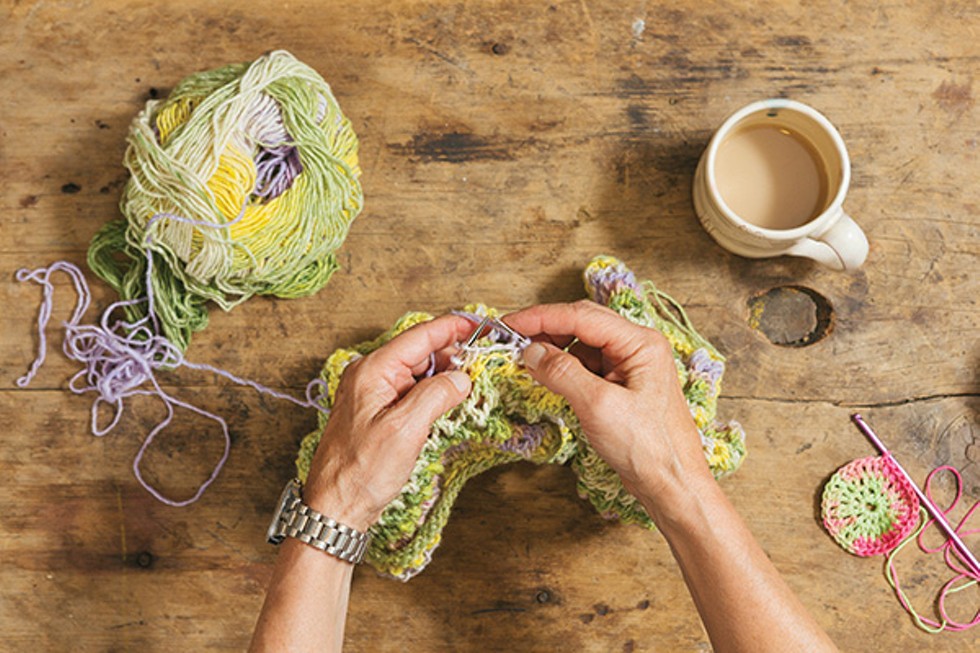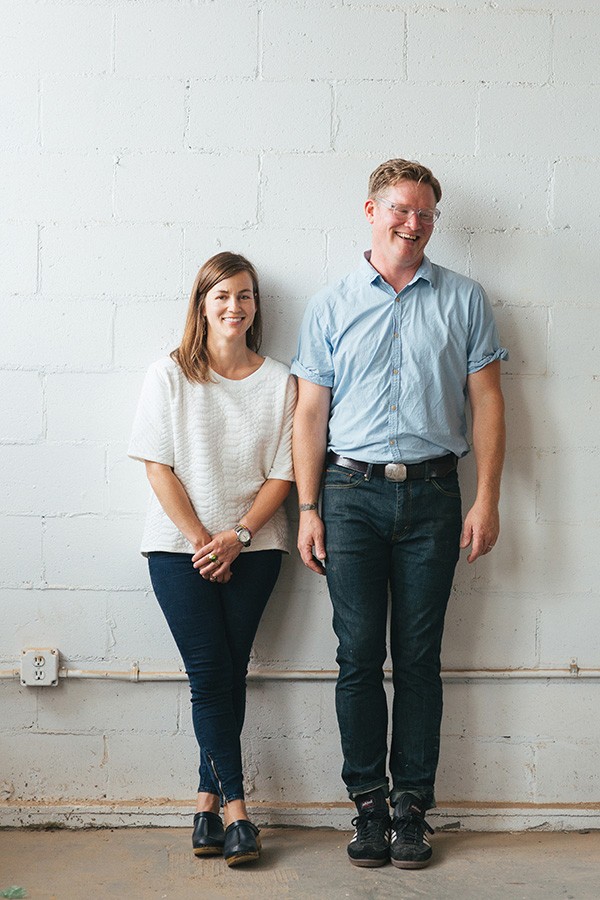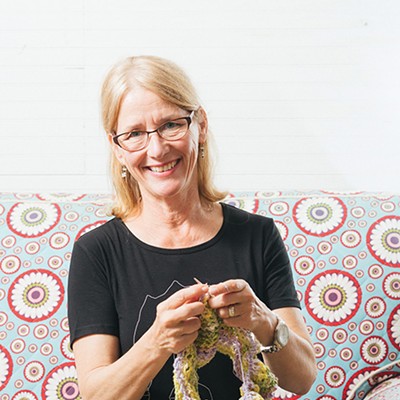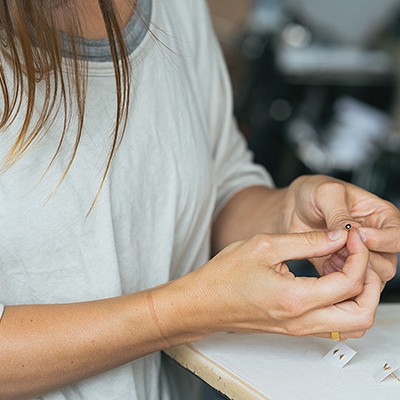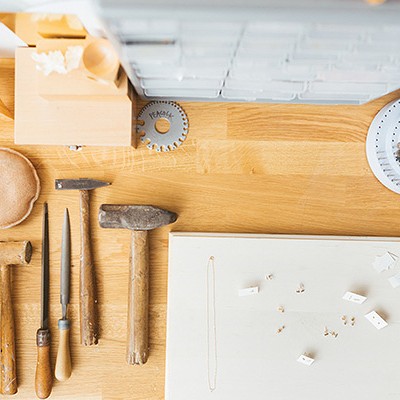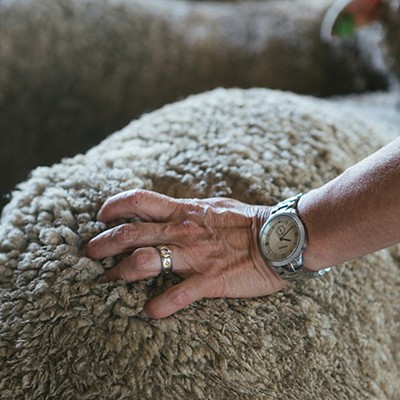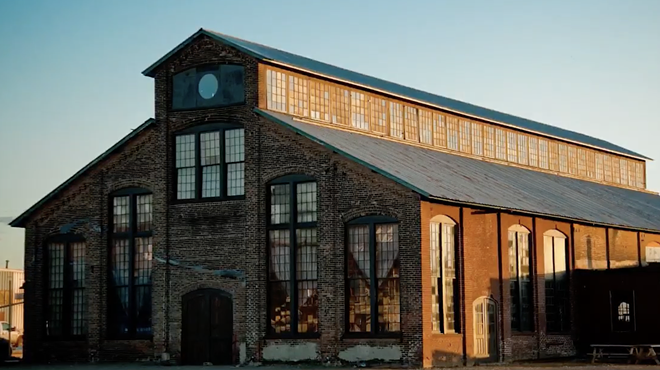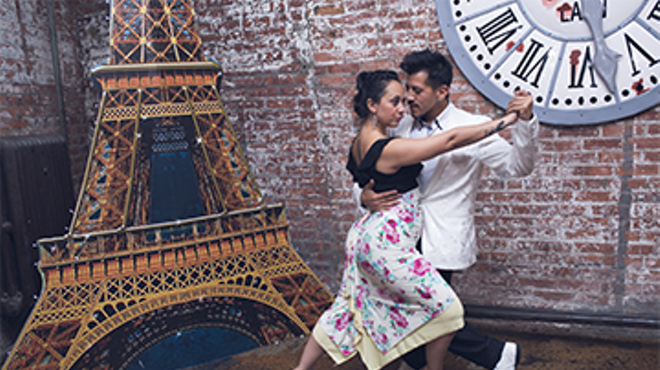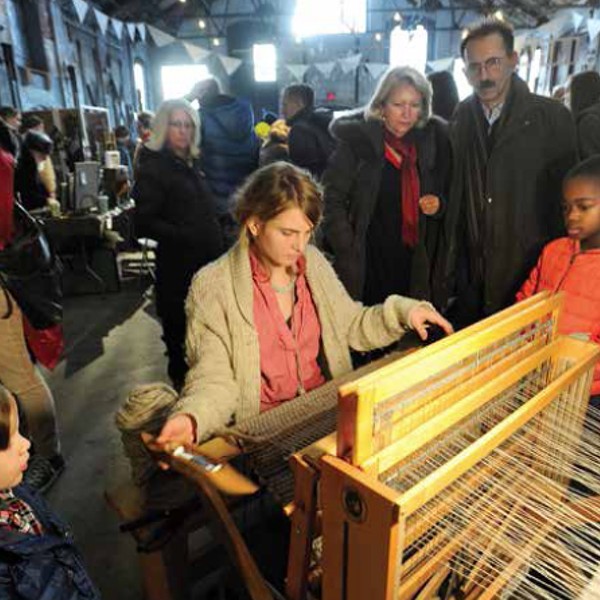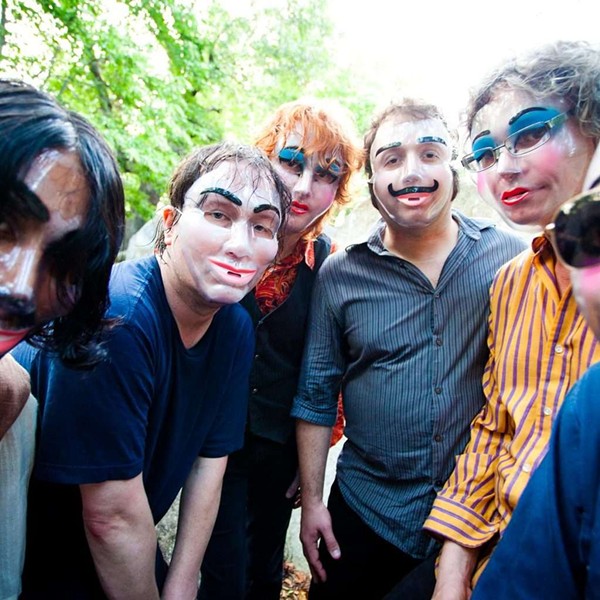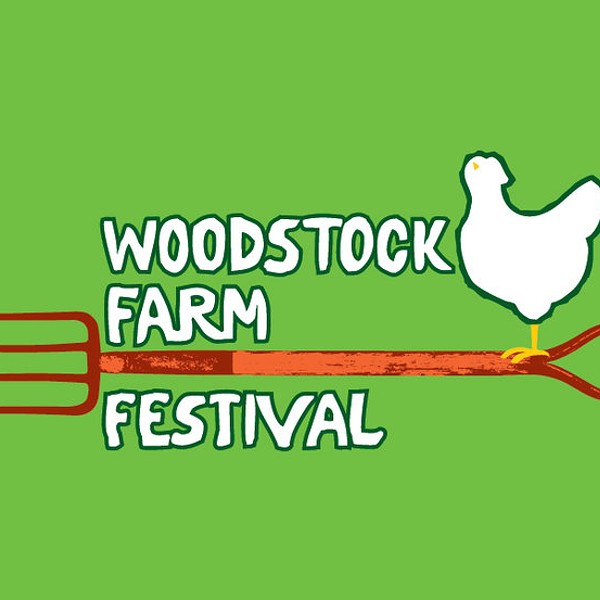Three years ago, Danielle Bliss and Joe Venditti were art school graduates struggling to find satisfying work when they started Wishbone Press. Working out of a loft in Kingston's Shirt Factory, they design and print cards, coasters, business cards, wedding invitations, and the like on four antique letterpresses. Their bold, eye-catching designs and messages keyed to the tastes of the under-30 crowd updates an archaic printing technology with wit and whimsy.
Besides an offbeat, hand-produced product, the couple are savvy marketers, deeply connected to the crafter community and also with their customers via Etsy. They network extensively through social media and curated a crafts fair last December in Uptown Kingston called the Hullabaloo. Despite the long hours and risks, "when you own your business and are doing something you love, it's satisfying," says Bliss. "People are finding a lot of value in handmade things. They don't want to support factories in China."
DIY Country
The indie craft movement is transforming the Hudson Valley into an artisan stronghold, and many of the crafters are people like Bliss and Venditti, who pursued their vision because they had absolutely nothing to lose and, by dint of talent, hard work, and frugal living, are living out their dream. Cheap space and a vibrant community of artists, artisans, and creative entrepreneurs are a definite lure, and many discover that the area's farms and thriving food culture make upstate living more satisfying than Brooklyn. "Friends from New York City wonder how I can adapt to this rural, small-town living, but it nurtures me," says Melissa Auf der Maur (bassist for Hole and Smashing Pumpkins), who moved to Hudson from the city with her partner Tony Stone, a filmmaker, six years ago. The couple are the creative directors of Basilica Hudson, a reclaimed factory in Hudson that hosts cultural events, including the Farm & Flea crafts fair. Much as in the 1960s, "people are returning to the land and wanting to be independent from an infrastructure they do not trust," Auf der Maur says.
Many crafters adhere to a do-it-yourself ethos that defies entrepreneurial conventions. Mary Ahern, owner of Angel Hill Apothecary, who makes natural skin-care products from plants foraged from her family's 140-acre farm in Chatham, is not anxious to expand, though demand is growing. Although she plans to hire someone to help with the harvesting and packaging, Ahern will continue to concoct her products—a process that involves drying the plants and infusing them in 100 percent organic hemp oil—herself. "I enjoy that aspect of making a really pure product," she says. Ahern regards other similar crafters not as competition but as part of her community. "Everyone's pretty small," she says. "We all learn from each other, and everyone's very supportive."
Quality Reigns
The craze for the handmade, be it knitted, sewed, crocheted, felted or woven, printed, painted or silk screened, carved or turned on a lathe, salvaged and forged, harvested from a field and mixed with edible oils, thrown on a potter's wheel, or glazed and fired, is clearly a reaction to the bland mechanization and chain-store standardization of daily life. Too many hours spent at the computer, lack of interesting, well-paid work and job security, as well as resistance to mass-market consumerism, with its labor exploitation, waste, and cheap, disposal products, are spurring a backlash. "It's a real paradigm shift," says Sherry Jo Williams, proprietor of Culture+Commerce, who formerly worked in the corporate sector as a designer and stylist but now is committed to promoting the two dozen crafters represented in her Hudson store. "People are willing to have less money, have a better quality of life, and spend more money on fewer things. It's a consensus in some sense that what you're eating and where your T-shirt was made matters."
In one sense, what's old is new again, given that the Hudson Valley has long been associated with crafts. Crafts People, a rustic complex representing 500 artisans in West Hurley, was founded by Rudy Hopkins, a ceramicist, in the 1960s. Its shelves of glazed pottery, glass ornaments, chimes, candles, wine racks, wooden toys, rocking chairs, silver jewelry, and the like reflect a traditional aesthetic that's long been a mainstay of area gift stores. The Woodstock-New Paltz Art & Craft Fair has been held twice yearly at the Ulster Fairgrounds for the past 33 years, drawing thousands to New Paltz each Memorial Day and Labor Day weekend.
But the indie craft movement is different from the crafts renaissance of the 1970s. For one, it has urban roots, growing out of the "Stitch and Bitch" knitting groups that cropped up in big cities a decade ago and the Renegade Craft Fair, first held in Chicago in 2003 (it attracted 250,000 people and has subsequently mushroomed into 11 cities). It has an edgier aesthetic, which values originality over slick perfection, and combines irreverence with the warm and homey, functionality with DIY production, and meticulous skill with wild experimentation.
The Etsy Factor
It also is deeply indebted to the Internet, which enables a crafter working out of her home to sell all over the world. The launch of the e-commerce craft emporium Etsy in 2005 spread the handmade gospel to the hinterlands, enabling makers in obscure corners of the country to tap into the global marketplace. Etsy, which generated $2.35 billion in sales in 2013, represents a million individual sellers who fit into one of three categories: supplies, vintage, and handmade. Eighty-eight percent are women. According to Etsy's member stories specialist Michelle Traub, these one-person start-ups are "independent, self-sufficient, and want to stay that way," in contrast with "stereotypical Silicon Valley entrepreneurs who want to quickly grow as big as possible."
In fact, Etsy, which is headquartered in Brooklyn, has a foothold in the Hudson Valley and is helping showcase the region as a crafts hotbed. In 2012 it opened a customer service annex in a converted warehouse in Hudson, which is furnished with maple-top desks made by local woodworker Rob Williams. Etsy founder Rob Kalin plans to convert a former mill building in Catskill into artisan workplaces with a general store selling the crafts produced on site. It would also consist of a restaurant serving locally sourced produce and a hotel with residential space—making crafts the engine of economic development and tourism.
Crystal Moore of Lock & Key Leathers is one of the thousands of crafters whose business wouldn't have been possible without Etsy. The 2012 college graduate, who recently relocated to Kingston with her husband from Oneonta, said she has "always been a maker" and learned her craft by working for a textile designer. Her leather and canvas bags, which are dyed and waxed for a distressed look, cost $195 to $325, but nonetheless have proved popular with students, with a loyal cohort based in California. "They write to me and say they're saving up for this bag, and a few months later they'll buy it," she says.
The Internet enables Moore to do all the marketing herself. "I'll put a new item on Etsy, Instagram it, blog about it, pin the bag on Pinterest, and go back to Etsy and see where my hits came from," she said. Her blog enables her to "market stuff from my point of view," which includes sharing her interests in motorcycles, cars, and food. Customers "want to know who you are, see what you're eating, and where you're going. It makes them feel more special." The fact that the bag they bought was "exclusive to them," rather than bearing the imprint of a well-known brand, is also important. "If there's a little bit of money in the bank and I'm doing it all myself, that's true happiness," she says.
Fair Thee Well
Besides Etsy, crafts fairs—ranging from small-scale gatherings of community vendors held in the local fire hall to carefully curated extravaganzas—are an essential component of the culture. Unlike trade shows, these grassroots events charge affordable fees and forge a sense of community. Notable recent examples here in the Hudson Valley include the aforementioned Hullabaloo and Hudson's Basilica Farm & Flea, which was held over last Thanksgiving weekend and attracted 3,500 visitors. Founder Auf der Maur, who describes it "as an alternative to the big-box Black Friday nightmare," said the event will be annual. Fairs are popping up all over the place this summer, including the second annual Hudson River Exchange in late June; Bazaar-on-Hudson, which was inspired by the Brooklyn Flea and will be held at The Living Room in Cold Spring Sundays through the end of July; and the Phoenicia Flea at the boutique hotel Graham & Co. on July 26 and 27.
The fairs have proved lucrative for some. "Celebrities are out shopping at the local fairs. It's not just my neighbor and my mom going to these things," notes Kingston-based jeweler Rebecca Peacock, who three years into founding her business was able to quit her day job. But Peacock, who forges her pieces from recycled metals sourced at refineries that process discarded jewelry, says it's not only the rich and famous who are buying her stuff. "It's almost going back to the 1880s, when shoes were really expensive and you kept those pairs of shoes and resoled them. People want less fake jewelry. Instead, they're choosing that one really beautiful thing. It's a move back to quality."
Patrick Turiello, co-owner of LayerXLayer, a husband-and-wife company that makes heavy canvas bags and backpacks from their Kingston loft, said a chance encounter with an actress who had started a company of compostable diapers at the Brooklyn Flea led to a large order. The couple farmed it out to a unionized New Jersey factory, doing the hand-sewn finishes themselves. LayerXLayer also sells through a distributor in Japan, where there's "a real interest in American-made products, especially vintage," he says. While factory manufacturing may seem anathema to the notion of handmade, Turiello said he and his wife, Leah Fabish, both art school graduates who started the company after they couldn't find jobs in their fields, consider themselves primarily designers. "We were makers because we had no choice," he says. "We had to decide whether we wanted to spend 60 to 70 hours a week making stuff or turn it into a real business."
The realities of the money economy have caused "a lot of people to transition from 'Hey, I want to do this thing' into turning it into a business," he adds. While some of their colleagues are committed "100 percent to making the thing, we like a little of both." Doing small-scale manufacturing wasn't possible before, but today factories are much more flexible in taking small orders, he said. LayerXLayer bags are sold in Japanese department stores, further defying small-is-beautiful notions of handmade.
The Gospel of Handmade
At the other extreme are the DIY proponents—crafter teachers and authors spreading the gospel of handmade. Cal Patch was a designer at Urban Outfitters who quit to start her own indie craft store on the Lower East Side before it was fashionable and then realized she could attract more customers by teaching them how to knit. Patch, who moved to Accord in 2008—she and her boyfriend have a mini homestead where they tend a garden and keep chickens—published a book, Do-It-Yourself Clothes: Patternmaking Simplified, and she continues to teach sewing and patternmaking, mainly at retreats located throughout the US. Teaching women how to design patterns and sew clothing that fits their particular body is a form of empowerment, which is helping the maker movement penetrate the mainstream, she believes. "Women who take my classes up here aren't hipsters. They're people who don't want to buy their clothes at Walmart anymore," says Patch.
Both Patch and Sally Russ, whose Sew Woodstock store sells sewing supplies and handmade clothes as well as hosts a sewing co-op, cite Alabama Chanin as the inspiration for a new model of clothing manufacture. The company, which was founded by designer Natalie Chanin after she left New York and returned to her hometown in Alabama, hires local women, including former unemployed textile workers, to hand stitch and embroider dresses made from organic cotton jersey. The dresses, which take weeks to sew, sell for thousands of dollars, a price tag that supports paying a fair wage. But Chanin also does something else that's unique: She open sources her designs by giving workshops around the country and selling her pattern books and fabrics. Fans who can't afford a $5,000 Alabama Chanin dress at Barney's have the option of making it themselves.
Chanin's vision to "bring systems of making to life," as she puts it, is an ambition shared by at least two indie craft businesses in the area. Jonah Meyer, whose eight-person shop is based in Kingston, said he'd like to someday hire 100 employees.
Meyer was a sculptor who made custom furniture before he created a brand by opening a showroom in Rhinebeck, which turned his distinctive handcrafted aesthetic, a mix of the traditional, modern, and whimsical, into a lifestyle, supported by a blog and website (business partner and wife Tara DeLisio was a key contributor to these developments). Today they operate Sawkille Co., which represents other furniture and craft makers as well. His high-end, heirloom-quality pieces are crafted of East Coast hardwoods sustainably harvested and hand finished.
Blackcreek Mercantile & Trading Company is another Kingston-based company that hopes to bring back handmade manufacturing. It currently employs several part-timers who assist co-owner and maker Josh Vogel in the production of hand-carved cutting boards, kitchen tools, and natural cutting board oil, which is formulated from locally sourced bee propolis, the gluelike substance in the hives.
Blackcreek sells its wares exclusively on a wholesale basis, including custom kitchen utensils for high-end, artisanal stores located as far afield as California, Paris, and Japan; national media coverage of the company has led to a book deal. Vogel said the competition is fierce; diversification of their product line and strategic, targeted marketing that seeks to build relationships helps them weather the various trends. "You have to pour your heart into what you're doing and the quality has to be there," says Vogel.
That sense of deep engagement with the material, of honest and elemental making, touches on the fundamental appeal of craft: authenticity.
The New Pioneers
For all its trumpeting of sincerity and goodness, the world of handmade is guilty of a snobbishness that borders on the xenophobic, according to Alexandra Dewez, owner of Harvey's Counter, a shop full of handmade goods in Hudson. Typically, customers show "a sudden lack of interest" when she informs them that the cool metal light that resembles an anchor studded with tiny bulbs they admire is from India. "Why should it be less worthy than something a Bard graduate made by hand? Not everyone in Central Asia works in a sweatshop or huge factory," says Dewez. Tiny collectives of women in Asia or Africa who make everything by hand and "thankfully through technology found an agent connected to Hudson" are involved in no less worthy an enterprise, and in such cases, each sale "really has an impact on their lives."
Then there's the fundamental problem of attrition and the sheer exhaustion and struggle of surviving in an economy based on efficiency. Paula Kucera owns White Barn Farm in New Paltz, where she has a shop selling yarn hand spun and hand dyed from wool sheared off her own sheep. "A lot of people burn out, because what they do is not sustainable in this money-driven world," she said. Plus, in her many years of holding classes in knitting, felting, plant dying, and sewing, she's found people are inconsistent: Someone will be "voracious about knitting for three years, then one day they put it down and don't want to do it." A new yarn shop opening up nearby can whittle down her potential pool of customers by half. To keep going, it's a matter of "finding out what's important, what you value, and what works for you. I may be shifting things around, start attending fiber festivals, go directly to the customers as a way to bump up sales."
As in decades past, many crafters will likely burn out. But today, the choices are fewer and the stakes are higher, thanks to the growing dominance of multinational corporations, notes Auf der Maur. She nonetheless has hope that a fundamental shift is under way. "In the city, most people can't avoid the propaganda that's everywhere, but here in the Hudson Valley we have isolated pockets of independent-minded communities," Auf der Maur says. "Craft and the effort of individual handmaking is a symbol of the future. What the world needs right now is a pair of hands." She added that crafters' inventiveness, work ethic, and entrepreneurial drive reflect the essence of being American. "Americans are pioneers who take risks and do weird and original things with a lot of will," she said. "A big part of the spirit in handmade is that people are taking their destiny into their own hands. There really is no choice."







